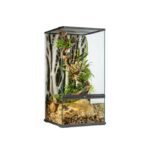
Ardentiella sp. Red diablo
16,50€ – 200,00€Price range: 16,50€ through 200,00€
Discover the beauty of Ardentiella sp. Red Diablo! Add color and life to your terrarium with this amazing isopod. Easy to care for, hardy and eye-catching, it is perfect for those looking for something unique. Make it part of your terrarium today!
**Previously belonged to the genus Merulanella.
Technical Data Sheet – Ardentiella sp. Red Diablo
**Previously belonged to the genus Merulanella.
Common name: Ardentiella Red Diablo Isopod
Scientific name: Ardentiella sp. Red Diablo
Family: Armadillidiidae
Origin: Asia, especially tropical regions of China and Southeast Asia.
Adult size: 0.5 – 1,5 cm
Life expectancy: 1 – 2 years under optimal conditions.
Description
The Ardentiella sp. Red Diablo is a small terrestrial isopod known for its striking combination of colors. Its body is predominantly red and black, with some parts showing yellow or other colors. This variety of colors makes it especially attractive to terrarium enthusiasts looking to add a splash of vibrancy to their setups.
Natural Habitat
- Temperature: Between 22°C and 26°C (72°F – 79°F).
- Humidity: Requires high humidity, ideally between 80% and 90%.
- Substrate: Prefers a moisture-retaining substrate, such as coconut fiber mixed with sphagnum moss and dry leaves.
Behavior
- Nocturnal isopods, mainly active during the night.
- They tend to hide during the day under leaves, bark, or in moist areas of the substrate.
- They are not particularly fast and are easy to handle.
Feeding
- Omnivores: Their diet consists of decaying organic matter, such as dry leaves, rotting wood, and occasionally, fruits and vegetables.
- It’s recommended to provide calcium supplements, like crushed eggshells, to support the development of their exoskeleton.
Reproduction
- Reproduction is ovoviviparous, with young developing in the female’s marsupium until they hatch.
- They are prolific and can reproduce multiple times a year under suitable conditions.
Care in Captivity
- Ventilation: They need a balance between ventilation and humidity; ensure the terrarium has holes for adequate air circulation.
- Cleaning: Regularly remove food remains and keep the substrate clean to prevent mold and bacteria growth.
Observations
The Ardentiella sp. Red Diablo is an exotic species that adapts well to tropical terrariums and is ideal for those looking to add color to their isopod collection. It’s recommended for keepers with basic experience in caring for isopods due to its specific humidity and temperature requirements.
| Options |
1 unit ,5 units ,10 units |
|---|
Related products
Creobroter gemmatus
Sold out
Dola larvae (pachnoda)
there is stock
Cubaris jupiter
there is stock
Cubaris panda king
there is stock
Gromphadorhina portentosa
there is stock
Phyllocrania paradoxa
Sold out
Shelfordella lateralis (ex tartara)(10 units)
there is stock
Armadillidium klugii
Sold out

























